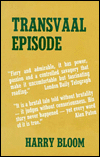Rifles and Shirt Collars
Review of Transvaal Episode by Harry Bloom. Second Chance Press. 320 pages, $15.95.

Harry Bloom's first novel, published under the title Episode in 1956, won him the British Authors Club Award but was largely neglected. Issued again as Transvaal Episode in 1981, it seems well on its way to being neglected again. Yet for those who know South Africa's history, the reappearance of this novel of a race riot in a Transvaal town -- first released in the year of the Treason Trial, four years before the Sharpeville Massacre -- is a troubling reminder of the continued currency of racial violence in South Africa.
Transvaal Episode is set in 1953 in the black "location" outside the town of Nelstroom. Its main characters are three: Walter Mabaso, an educated black newcomer, who becomes the spokesperson of the location, Hendrik du Toit, the punctilious white location superintendent, and Lieutenant Swanepoel, the intelligent but brutal police chief. Bloom is slow to launch into his plot, and the first few chapters drag somewhat as he paints in the backdrop and introduces his characters. But beginning with the words "There was a washwoman in Nelstroom location named Mary Lukhele," a powerful machine is set in motion.
The book's central theme is the violence inherent in apartheid, and in demonstrating this Bloom shows a rare understanding of the workings of violence itself. Beginning with a dispute over a missing shirt collar, the violence picks up momentum. A botched police raid, a new edict and a public meeting lead inexorably to a catastrophic, even apocalyptic reign of terror. The author is strongest in scenes of conflict: panicky policemen on a night operation who end up shooting at one another, attempted arrests that turn into killings, the destruction of the superintendent's new car. He has a deft hand, too, with the political uses of language -- the bitter irony Du Toit's black assistant injects into his "translations" of the superintendent's speeches, and especially one long Orwellian scene in which Swanepoel, in taking down Du Toit's statement on a huge pass-law protest, alters Du Toit's own memory of these events and establishes a distorted, self-serving version that will become the official history of that day. (The emergence of a Colonel T.J. Swanepoel of Johannesburg as one of South Africa's worst Security Police bullies and torturers is only one way Bloom's book has been imitated by life.)
The sometimes horrifying violence in the latter half of the book is saved from sensationalism by the rigorous exposition of the participants' psychology and motivations and by a rather cold, flat literary style. Bloom is not just a specialist in Sturm und Drang, though. When the storm has passed he gives us one of the book's quietest and most effective scenes. Alone in his room, Walter Mabaso, a hunted man, takes out his cherished copy of Livingstone's Missionary Travels in South Africa and glances through it. It is a book illustrated with "quaint, stilted engravings" and a text "full of damning and telling surprises."
On a certain page there was a description of the land of the Bechuana -- a land rich in pastures and woods and streams: a land of plentiful game and great cattle herds and bustling African towns and villages. That had never ceased to amaze him, for there was nothing left of it now. That part was now a waste of sand and scrub -- desert. How had it happened? How had the life been wrung out of the land?
There is much that is damning and telling in Transvaal Episode too, but by now, sadly, none of it is surprising. The ugliness in this book has only been confirmed in the generation of apartheid that has followed it.
Published in IDAF News Notes, April 1983.


